Valorization of a Highly Organic Sediment: From Conventional Binders to a Geopolymer Approach
Abstract
:1. Introduction
2. Materials and Methods
2.1. Dredged Sediments
2.2. Low-Carbon (Pozzolanic) Binders
2.2.1. Ground-Granulated Blast-Furnace Slag (GGBS)
2.2.2. Fly Ash (FA)
2.2.3. Activator (NeoliX®)
2.3. Traditional Hydraulic Binders
2.4. Methodology
2.4.1. Binder Selection
- -
- Low-carbon binders, e.g., eco-binder NeoliX® (used as an activator with a mineral charge).
- -
- Pozzolanic by-product as FA (sodeline).
- -
- GGBS binders, e.g., Ecocem (an ecofriendly solution).
- -
- Specific binders, e.g., Neutracem or CSA cement (with high clinkers).
- -
- Ordinary Portland cement (OPC) (cement mostly consisted of clinker) with or without the addition of lime, depending upon the percentage of organic matter present in the sediments.
2.4.2. Lime Fixation
2.4.3. Sample Preparation
3. Results and Discussion
3.1. Valorization Using Hydraulic Binder
3.2. Valorization Using Pozzolanic Binder (Co-Valorization)
4. Conclusions
- -
- The UCS values obtained ranged from 0.12 to 0.21 MPa for M1, 0.43 to 0.60 MPa for M2, 0.45 to 0.80 MPa for M3, 0.42 to 0.75 MPa for M4, 0.27 to 0.65 MPa for M5, and 0.38 to 0.50 MPa for M6. Similarly, the CBR values were below 35% for each formulation from M0 to M6. These values did not match with the required values for road sublayers’ application according to the French road engineering guide, GTR (2000).
- -
- Formulation M7, which included 9% OPC and 2% FA, had the maximum UCS (1 MPa) after 60 days, with a maximum tensile strength of 0.14 MPa at 28 days, and the maximum value of CBR was 33.68. The estimated value of tensile strength at 360 days for materials treated with OPC can be calculated from measured values at 28 days as per Equation (1) according to the French standard NF EN 14227-1, 2013:
- -
- The addition of lime had a positive effect on strength development in formulations M3 and M4: more lime, higher UCS. Lime was used against OM: increases were seen in UCS because lime plays a role on the OM activity and decreased its inhibition against hydration.
- -
- The addition of a granular corrector did not yield positive results, which could be due to the high sand content (>25%) already present in the dredged sediments.
- -
- The relatively low-carbon print CSA cement, as compared to OPC, did not show promising results. Like OPC, CSA cement also had difficulty in stabilizing these sediments due to the presence of a high OM content (>17%).
- -
- After a series of testing, the optimal water to solid mass ratio (W/S ratio) was decided to be 0.50, as below this ratio, mechanical strength values significantly decrease. A panel of 5 tests were performed, that included 10% to 50% of dredged sediments to observe the strength development. The influence of the addition of sediments in the silicate-activated system revealed that the UCS value had decreased. At 30% by weight of dredged sediments’ addition to the geopolymer (activator + GGBS), the UCS value obtained was above 2 MPa at 28, 60, 90, and 180 days.
- -
- Three tests were carried out on the addition of calcium, either with lime or granular calcium carbonate (granicalcium). A significant increase in UCS was observed, where the addition of 5% lime increased the UCS up to 60% and Rt up to 25%, while the addition of 3% granular calcium carbonate increased the UCS up to 90% and Rt up to 30%.
- -
- With the UCS and Rt levels obtained, it will be possible to consider these geo-composites as road sublayer materials with adapted processes in practice.
Author Contributions
Funding
Institutional Review Board Statement
Informed Consent Statement
Data Availability Statement
Acknowledgments
Conflicts of Interest
Future Work Recommendations
References
- Alzieu, C. (Ed.) Dragages et Environnement Marin: État des Connaissances = Dredging and Marine Environment: State of the Art; IFREMER: Plouzané, France, 1999; p. 223. ISBN 2-84433-014-2. Available online: https://www.vliz.be/en/imis?refid=17902 (accessed on 5 May 2022).
- Blengini, G.A.; Garbarino, E. Resources and waste management in Turin (Italy): The role of recycled aggregates in the sustainable supply mix. J. Clean. Prod. 2010, 18, 1021–1030. [Google Scholar] [CrossRef]
- OSPAR Convention. Convention for the Protection of the Marine Environment of the North-East Atlantic, Paris. 1992, p. 33. Available online: https://www.ospar.org/convention (accessed on 5 May 2022).
- Barcelona Convention. Convention for the Protection of the Mediterranean Sea Against Pollution. 1995. Available online: https://www.unep.org/unepmap/ (accessed on 5 May 2022).
- London Convention Specific Guidelines for the Assessment of Dredged Material. Convention on the Prevention of Marine Pollution by Dumping of Wastes and Other Matter. 2000. Available online: https://www.gc.noaa.gov/documents/gcil_imo_dmaction.pdf (accessed on 5 May 2022).
- Cappuyns, V.; Deweirt, V.; Rousseau, S. Dredged sediments as a resource for brick production: Possibilities and barriers from a consumers’ perspective. Waste Manag. 2015, 38, 372–380. [Google Scholar] [CrossRef] [PubMed]
- Baksa, P.; Cepak, F.; Kovačič Lukman, R.; Ducman, V. An evaluation of marine sediments in terms of their usability in the brick industry: Case study Port of Koper. Journal of Sustainable Development of Energy. Water Environ. Syst. 2018, 6, 78–88. [Google Scholar] [CrossRef] [Green Version]
- Mesrar, L.; Benamar, A.; Duchemin, B.; Brasselet, S.; Bourdin, F.; Jabrane, R. Engineering properties of dredged sediments as a raw resource for fired bricks. Bull. Eng. Geol. Environ. 2021, 80, 2643–2658. [Google Scholar] [CrossRef]
- Kreirzti, L.K.; Benamara, L.; Boudjenane, N.E. Valorization of dredging sediments of dam BOUHNIFIA in ceramic. J. Aust. Ceram. Soc. 2019, 55, 1081–1089. [Google Scholar] [CrossRef]
- Slimanou, H.; Baziz, A.; Bouzidi, N.; Quesada, D.E.; Tahakourt, A. Thermal, physical, mechanical and microstructural properties of dredged sediment-based ceramic tiles as substituent of kaolin. Environ. Sci. Pollut. Res. 2022, 29, 26792–26809. [Google Scholar] [CrossRef] [PubMed]
- Couvidat, J.; Benzaazoua, M.; Chatain, V.; Bouamrane, A.; Bouzahzah, H. Feasibility of the reuse of total and processed contaminated marine sediments as fine aggregates in cemented mortars. Constr. Build. Mater. 2016, 112, 892–902. [Google Scholar] [CrossRef] [Green Version]
- Anger, B.; Moulin, I.; Commene, J.P.; Thery, F.; Levacher, D. Fine-grained reservoir sediments: An interesting alternative raw material for Portland cement clinker production. Eur. J. Environ. Civ. Eng. 2019, 23, 957–970. [Google Scholar] [CrossRef]
- Bhatty, J.I. Role of Minor Elements in Cement Manufacture and Use. In Research and Development Bulletin RD109T; Portland Cement Association: Skokie, IL, USA, 1995; 40p, Available online: https://trid.trb.org/view/461431 (accessed on 5 May 2022).
- Weimer, M.; Dalton, J.; Gardner, K.; Magee, B. Beneficial use of contaminated dredged sediments in Portland cement manufacture. In Dredging’02: Key Technologies for Global Prosperity, Processing of the Third Specialty Conference on Dredging and Dredged Material Disposal, Orlando, FL, USA, 5–8 May 2002; American Society of Civil Engineers: Reston, VA, USA, 2003; pp. 1–10. [Google Scholar] [CrossRef]
- Chu, D.C.; Kleib, J.; Amar, M.; Benzerzour, M.; Abriak, N.E. Recycling of dredged sediment as a raw material for the manufacture of Portland cement–Numerical modeling of the hydration of synthesized cement using the CEMHYD3D code. J. Build. Eng. 2022, 48, 103871. [Google Scholar] [CrossRef]
- Safer, O.; Belas, N.; Belaribi, O.; Belguesmia, K.; Bouhamou, N.; Mebrouki, A. Valorization of Dredged Sediments as a Component of Vibrated Concrete: Durability of These Concretes Against Sulfuric Acid Attack. Int. J. Concr. Struct. Mater. 2018, 12, 44. [Google Scholar] [CrossRef]
- Dubois, V.; Abriak, N.E.; Zentar, R.; Ballivy, G. The use of marine sediments as a pavement base material. Waste Manag. 2009, 29, 774–782. [Google Scholar] [CrossRef] [PubMed]
- Zentar, R.; Abriak, N.E.; Dubois, V.; Miraoui, M. Beneficial use of dredged sediments in public works. Environ. Technol. 2009, 30, 841–847. [Google Scholar] [CrossRef] [PubMed]
- Maherzi, W.; Benzerzour, M.; Mamindy-Pajany, Y.; van Veen, E.; Boutouil, M.; Abriak, N.E. Beneficial reuse of Brest-Harbor (France)-dredged sediment as alternative material in road building: Laboratory investigations. Environ. Technol. 2018, 39, 566–580. [Google Scholar] [CrossRef] [PubMed]
- Wang, D.X.; Abriak, N.E.; Zentar, R.; Xu, W. Solidification/stabilization of dredged marine sediments for road construction. Environ. Technol. 2012, 33, 95–101. [Google Scholar] [CrossRef] [PubMed]
- Zentar, R.; Wang, H.; Wang, D. Comparative study of stabilization/solidification of dredged sediments with ordinary Portland cement and calcium sulfo-aluminate cement in the framework of valorization in road construction material. Constr. Build. Mater. 2021, 279, 122447. [Google Scholar] [CrossRef]
- Chompoorat, T.; Thepumong, T.; Taesinlapachai, S.; Likitlersuang, S. Repurposing of stabilised dredged lakebed sediment in road base construction. J. Soils Sediments 2021, 21, 2719–2730. [Google Scholar] [CrossRef]
- Gupta, A.; Arora, V.K.; Biswas, S. Contaminated dredged soil stabilization using cement and bottom ash for use as highway subgrade fill. Geo-Engineering 2017, 8, 20. [Google Scholar] [CrossRef] [Green Version]
- Jamsawang, P.; Charoensil, S.; Namjan, T.; Jongpradist, P.; Likitlersuang, S. Mechanical and microstructural properties of dredged sediments treated with cement and fly ash for use as road materials. Road Mater. Pavement Des. 2021, 22, 2498–2522. [Google Scholar] [CrossRef]
- Said, I.; Missaoui, A.; Lafhaj, Z. Reuse of Tunisian marine sediments in paving blocks: Factory scale experiment. J. Clean. Prod. 2015, 102, 66–77. [Google Scholar] [CrossRef]
- Siham, K.; Fabrice, B.; Edine, A.N.; Patrick, D. Marine dredged sediments as new materials resource for road construction. Waste Manag. 2008, 28, 919–928. [Google Scholar] [CrossRef]
- Rakshith, S.; Singh, D.N. Utilization of Dredged Sediments: Contemporary Issues. J. Waterw. Port Coast. Ocean Eng. 2017, 143, 1–13. [Google Scholar] [CrossRef]
- Potgieter, J.H. An Overview of Cement production: How “green” and sustainable is the industry? Environ. Manag. Sustain. Dev. 2012, 1, 14–37. [Google Scholar] [CrossRef] [Green Version]
- Capasso, I.; Liguori, B.; Ferone, C.; Caputo, D.; Cioffi, R. Strategies for the valorization of soil waste by geopolymer production: An overview. J. Clean. Prod. 2021, 288, 125646. [Google Scholar] [CrossRef]
- Ferone, C.; Liguori, B.; Capasso, I.; Colangelo, F.; Cioffi, R.; Cappelletto, E.; Di Maggio, R. Thermally treated clay sediments as geopolymer source material. Appl. Clay Sci. 2015, 107, 195–204. [Google Scholar] [CrossRef]
- Karam, R.; Bulteel, D.; Wattez, T.; Deneele, D. Effect of marine sediments incorporation on the behaviour of alkali-activated GGBFS. Mater Struct. 2019, 52, 110. [Google Scholar] [CrossRef]
- Komnitsas, K. Co-valorization of marine sediments and construction & demolition wastes through alkali activation. J. Environ. Chem. Eng. 2016, 4 Pt A, 4661–4669. [Google Scholar] [CrossRef]
- Liao, Y.-C.; Huang, C.-Y.; Chen, Y.-M. Lightweight aggregates from water reservoir sediment with added sodium hydroxide. Constr. Build. Mater. 2013, 46, 79–85. [Google Scholar] [CrossRef]
- Molez, L.; Diop, M.B.; Ka, M.; Lanos, C. Valorisation de Déchets Minéraux par Géopolymérisation; 36ème Rencontres Universitaires de Génie Civil de l’AUGC: Saint-Etienne, France, 2018; Available online: https://hal.archives-ouvertes.fr/hal-01852521 (accessed on 5 May 2022).
- Molino, B.; De Vincenzo, A.; Ferone, C.; Messina, F.; Colangelo, F.; Cioffi, R. Recycling of clay sediments for geopolymer binder production. A new perspective for reservoir management in the framework of Italian legislation: The Occhito reservoir case study. Materials 2014, 7, 5603–5616. [Google Scholar] [CrossRef]
- Lirer, S.; Liguori, B.; Capasso, I.; Flora, A.; Caputo, D. Mechanical and chemical properties of composite materials made of dredged sediments in a fly-ash based geopolymer. J. Environ. Manag. 2017, 191, 1–7. [Google Scholar] [CrossRef]
- Korniejenko, K.; Kozub, B.; Bak, A.; Balamurugan, P.; Uthayakumar, M.; Furtos, G. Tackling the circular economy challenges—Composites recycling: Used tyres, wind turbine blades, and solar panels. J. Compos. Sci. 2021, 5, 243. [Google Scholar] [CrossRef]
- Junakova, N.; Junak, J. Sustainable use of reservoir sediment through partial application in building material. Sustainability 2017, 9, 852. [Google Scholar] [CrossRef] [Green Version]
- Duxson, P.; Fernández-Jiménez, A.; Provis, J.L.; Lukey, G.C.; Palomo, A.; van Deventer, J.S.J. Geopolymer technology: The current state of the art. J. Mater. Sci. 2006, 42, 2917–2933. [Google Scholar] [CrossRef]
- Duxson, P.; Provis, J.L.; Lukey, G.C.; van Deventer, J.S.J. The role of inorganic polymer technology in the development of “green concrete”. Cem. Concr. Res. 2007, 37, 1590–1597. [Google Scholar] [CrossRef]
- Kong, D.L.Y.; Sanjayan, J.G. Effect of elevated temperatures on geopolymer paste, mortar and concrete. Cem. Concr. Res. 2010, 40, 334–339. [Google Scholar] [CrossRef]
- Zhang, J.; Shi, C.; Zhang, Z.; Ou, Z. Durability of alkali-activated materials in aggressive environments: A review on recent studies. Constr. Build. Mater. 2017, 152, 598–613. [Google Scholar] [CrossRef]
- Silitonga, E. Valorisation des Sédiments Marins Contaminés par Solidification/Stabilisation à Base de Liants Hydrauliques et de Fumée de Silice. Ph.D. Thesis, Université de Caen, Caen, France, 2010; 229p. Available online: https://tel.archives-ouvertes.fr/tel-00705226 (accessed on 5 May 2022).
- Kribi, S. Décomposition des Matières Organiques et Stabilisation des Métaux Lourds Dans Les Sédiments de Dragage. Ph.D. Thesis, INSA Lyon, Lyon, France, 2005; pp. 220–221. Available online: http://theses.insa-lyon.fr/publication/2005ISAL0064/these.pdf (accessed on 5 May 2022).
- Hamouche, F.; Zentar, R. Effects of organic matter on physical properties of dredged marine sediments. Waste Biomass Valorization 2020, 11, 389–401. [Google Scholar] [CrossRef]
- Malkawi, A.I.H.; Alawneh, A.S.; Abu-Safaqah, O.T. Effects of organic matter on the physical and the physicochemical properties of an illitic soil. Appl. Clay Sci. 1999, 14, 257–278. [Google Scholar] [CrossRef]
- Ekwue, E.I. Organic-matter effects on soil strength properties. Soil Tillage Res. 1990, 16, 289–297. [Google Scholar] [CrossRef]
- Rashid, M.A.; Brown, J.D. Influence of marine organic compounds on the engineering properties of a remoulded sediment. Eng. Geol. 1975, 9, 141–154. [Google Scholar] [CrossRef]
- Booth, J.S.; Dahl, A.G. A note on the relationships between organic matter and some geotechnical properties of a marine sediment. Mar. Geotechnol. 1986, 6, 281–297. [Google Scholar] [CrossRef]
- Kujala, K.; Mäkikyrö, M.; Lehto, O. Effect of humus on the binding reaction in stabilized soils. In Proceedings of the International Conference on ground Improvement Geosystems, 2, IS-Tokyo’96, Grouting and Mixing, Tokyo, Japan, 14–17 May 1996; Volume 1, pp. 415–419. Available online: https://ci.nii.ac.jp/naid/10012499168/#cit (accessed on 5 May 2022).
- Colin, D. Valorisation de Sédiments Fins de Dragage en Technique Routière. Ph.D. Thesis, Université de Caen, Caen, France, 2003. Available online: https://www.theses.fr/2003CAEN2038 (accessed on 5 May 2022).
- Levacher, D.; Sanchez, M.; Duan, Z.; Le Guern, C. Propriétés Physiques et Hydrauliques de Sédiments Marins en vue de Réutilisation en Remblais. In Xèmes Journées Nationales Génie Côtier—Génie Civil; Sophia Antipolis: Valbonne, France, 14–16 October 2008; pp. 761–774. Available online: https://10.5150/jngcgc.2008.072-L (accessed on 5 May 2022).
- Dubois, V. Etude du Comportement Physico-Mécanique et Caractérisation Environnementale des Sédiments Marins–Valorisation en Technique Routière. Ph.D. Thesis, Université d’Artois, Béthune, France, 2006. Available online: http://cdoc.ensm-douai.fr/theses/VincentDubois.pdf (accessed on 5 May 2022).
- GTR—Guide Des Terrassements Routiers, Réalisation des Remblais et des Couches de Forme, Guide Technique, LCPC, SETRA Paris. 2ème Edition. 2000. Available online: https://www.ecovegetal.com/multimedia/pdf/guide_des_terrassements_routiers_070515002018.pdf?1430950908 (accessed on 5 May 2022).
- Chew, S.H.; Kamruzzaman, A.H.M.; Lee, F.H. Physicochemical and engineering behavior of cement treated clays. J. Geotech. Geoenvironmental. Eng. 2004, 130, 696–706. [Google Scholar] [CrossRef]
- Le Guern, M.; Boutouil, M.; Saussaye, L.; Lescarmontier, D. Geotechnical and mechanical characterisation of three marine dredged sediments treated with hydraulic binders. In Proceedings of the South Baltic Conference on Dredged Materials in Dike Construction, Rostock, Germany, 10–14 April 2014; Available online: http://www.dredgdikes.eu/wp-content/uploads/01_Le%20Guern_WEB.pdf (accessed on 5 May 2022).
- Furlan, A.P.; Razakamanantsoa, A.; Ranaivomanana, H.; Amiri, O.; Levacher, D.; Deneele, D. Effect of Fly Ash on microstructural and resistance characteristics of dredged sediment stabilized with lime and cement. Constr. Build. Mater. 2021, 272, 121637. [Google Scholar] [CrossRef]
- Nguyen, T.T.M.; Rabbanifar, S.; Brake, N.A.; Qian, Q.; Kibodeaux, K.; Crochet, H.E.; Jao, M. Stabilization of silty clayey dredged material. J. Mater. Civ. Eng. 2018, 30, 04018199. [Google Scholar] [CrossRef]
- Tremblay, H.; Leroueil, S.; Locat, J. Mechanical improvement and vertical yield stress prediction of clayey soils from eastern Canada treated with lime or cement. Can. Geotech. J. 2001, 38, 567–579. [Google Scholar] [CrossRef]
- SOIL SURVEY STAFF. Soil Survey Manual; USDA Handbook No. 18; U.S. Department of Agriculture Washington: Washington, DC, USA, 1951; 503p.
- Decree of 9 August 2006 Concerning Levels to Be Taken into Account When Analyzing Discharges into Water Surfaces or Marine Sediments, Estuarine or Stream or Canal Extracts. Available online: https://www.legifrance.gouv.fr/affichTexte.do?cidTexte=JORFTEXT000000423497 (accessed on 16 May 2022).
- Folk, R.L. Petrology of Sedimentary Rocks; Hemphill Publishing Company: Austin, TX, USA, 1980. [Google Scholar]
- Binici, H.; Aksogan, O.; Cagatay, I.H.; Tokyay, M.; Emsen, E. The effect of particle size distribution on the properties of blended cements incorporating GGBFS and natural pozzolan (NP). Powder Technol. 2007, 177, 140–147. [Google Scholar] [CrossRef]
- Bourabah, M.A.; Abou-Bekr, N.; Taibi, S. Geotechnical Characterization of Dredging Sediments for Valorization in Road Embankments: Case of the Cheurfas Dam (Algeria); Geo-Florida 2010: Orlando, FL, USA, 20–24 February 2010; pp. 2212–2221. [Google Scholar] [CrossRef]
- Hamouche, F.; Zentar, R. Effects of organic matter on mechanical properties of dredged sediments for beneficial use in road construction. Environ. Technol. 2020, 41, 296–308. [Google Scholar] [CrossRef]
- Wang, D.; Abriak, N.E.; Zentar, R.; Chen, W. Effect of lime treatment on geotechnical properties of Dunkirk sediments in France. Road Mater. Pavement Des. 2013, 14, 485–503. [Google Scholar] [CrossRef]
- Schlue, B.F.; Kreiter, S.; Moerz, T. Time-dependent deformation of dredged harbor mud used as backfilling material. J. Waterw. Port Coast. Ocean Eng. 2009, 135, 154–163. [Google Scholar] [CrossRef]
- SETRA-LCPC. Assises de chaussées en graves nontraitées et matériaux traités aux liants hydrauliques et pouzzolaniques, Guide d’application des normes pour le réseau routier national. In Surfacing Layers Made of Unbound Materials and Hydraulically or Pozzolanically Bound Materials, Guide of Application of the Standards for the National Road Network; Bagneux-LCPC: Paris, France, 1998. [Google Scholar]
- Aydın, S.; Baradan, B. Effect of activator type and content on properties of alkali-activated slag mortars. Compos. Part B Eng. 2014, 57, 166–172. [Google Scholar] [CrossRef]
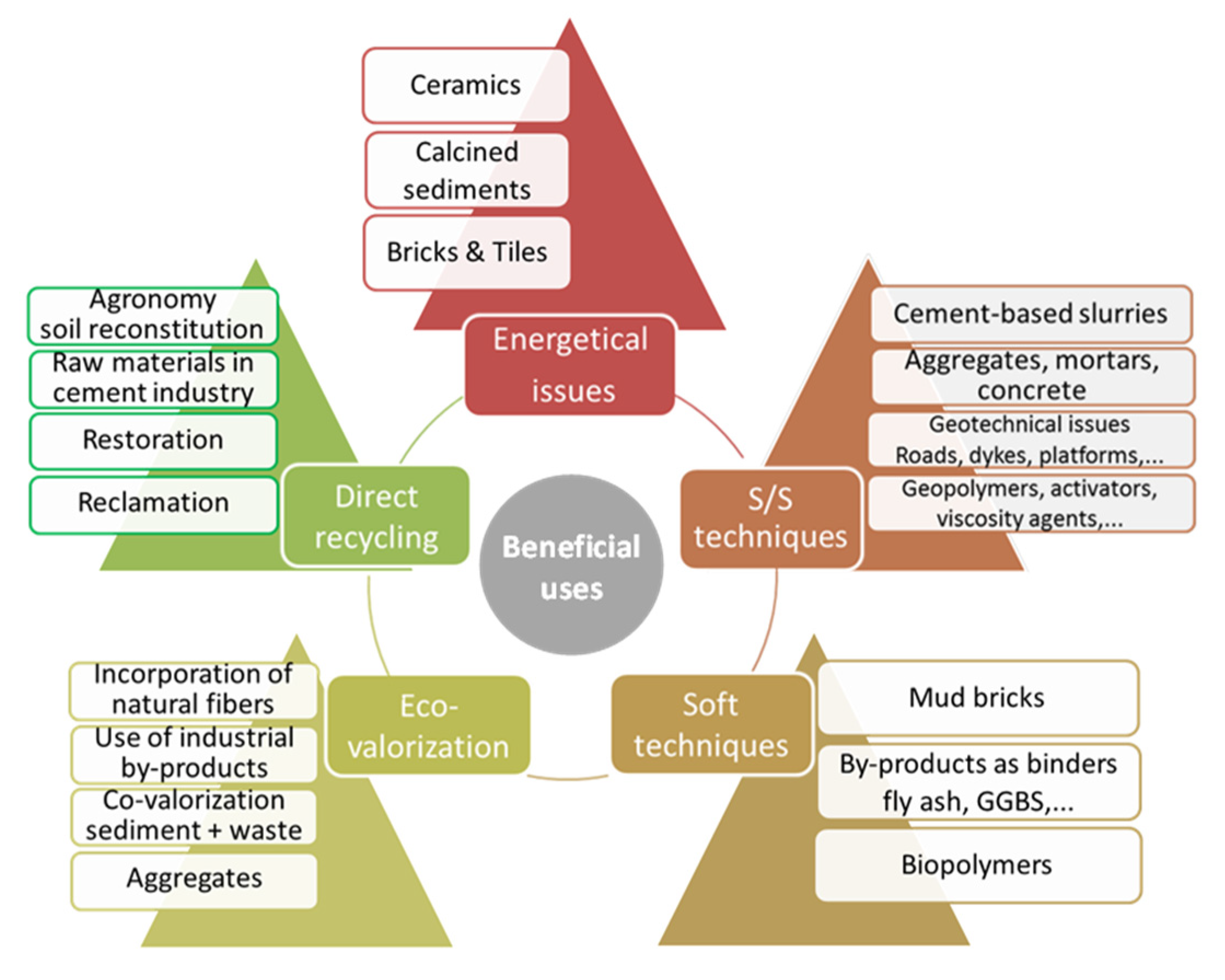
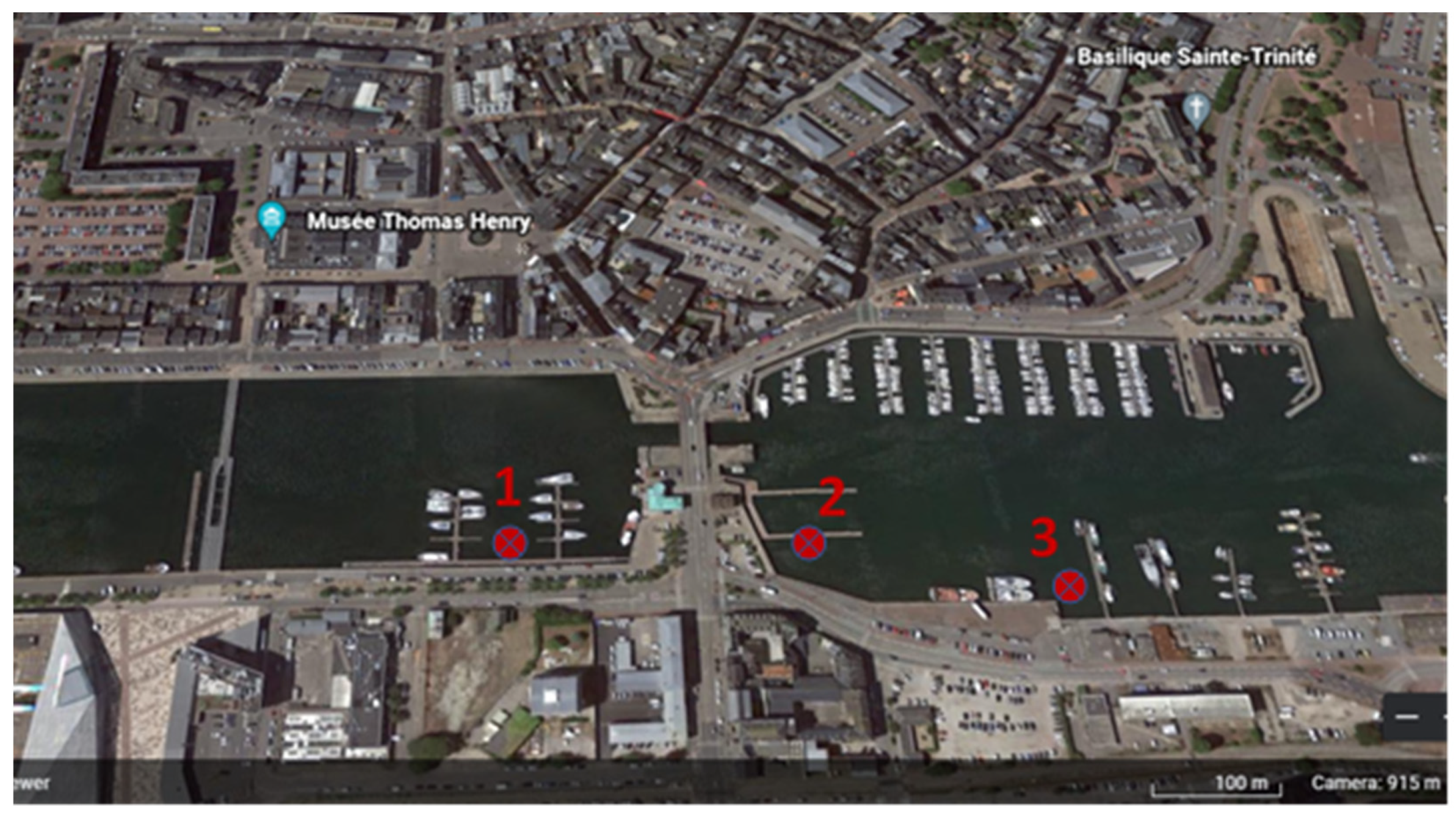
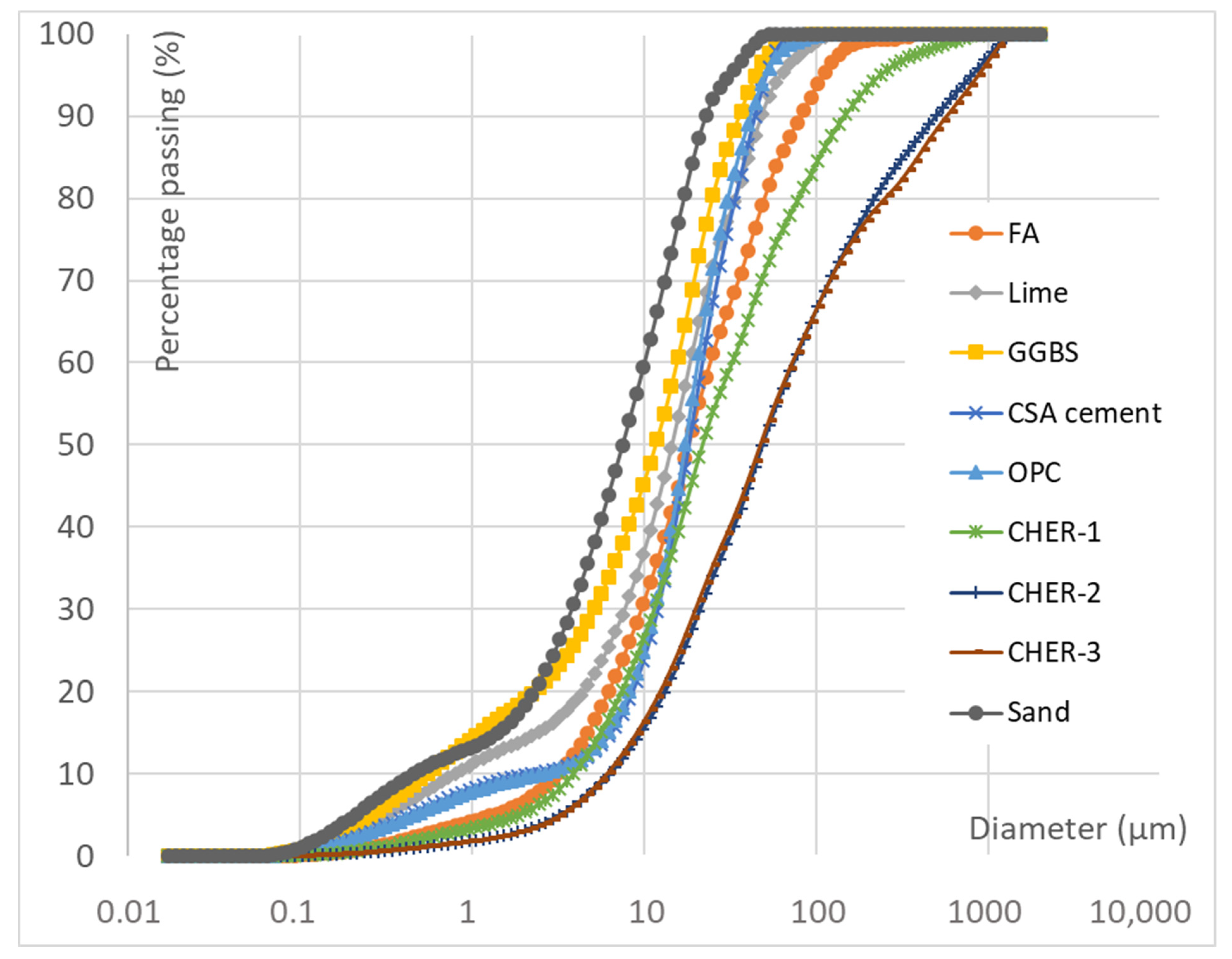
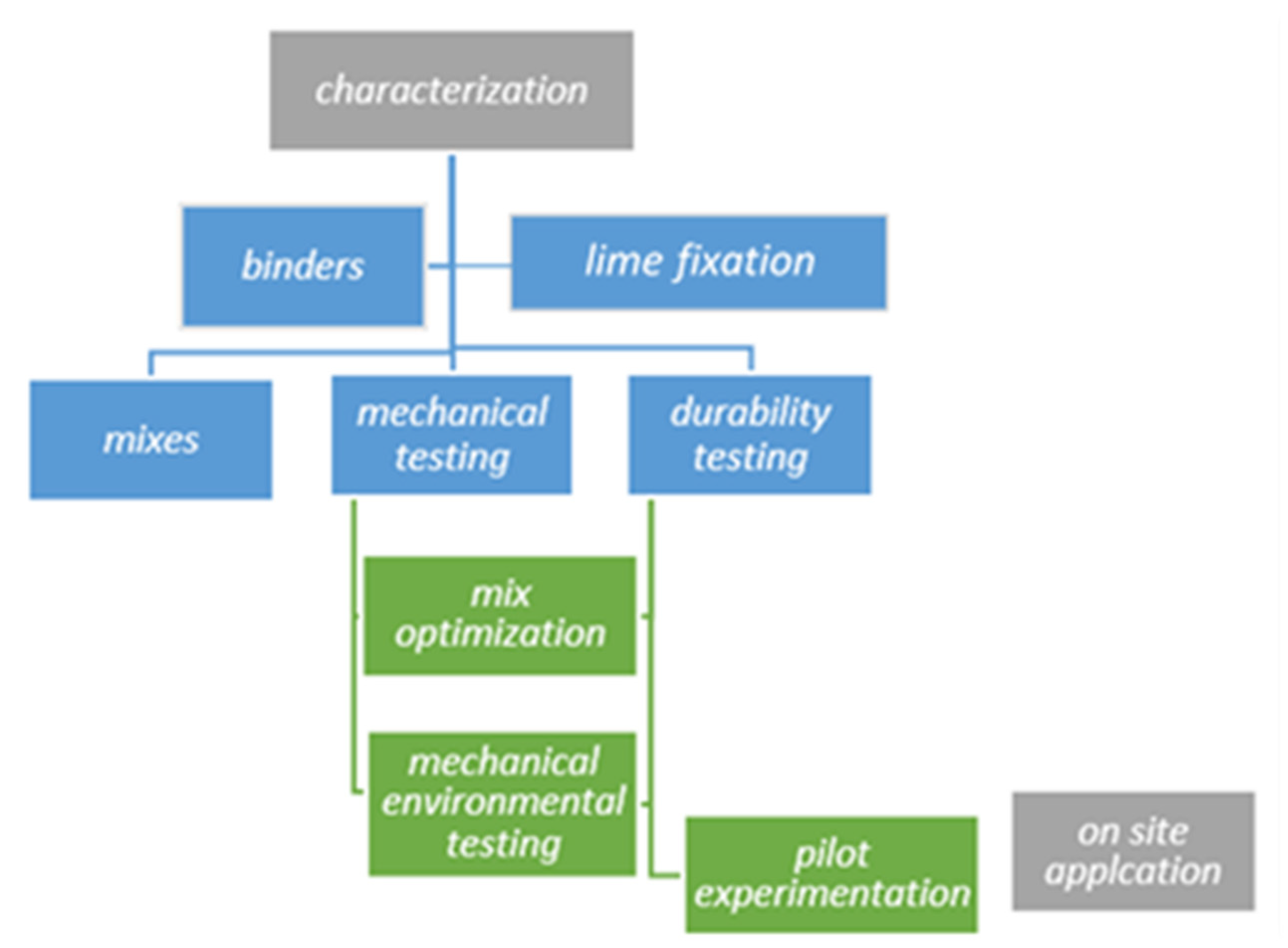
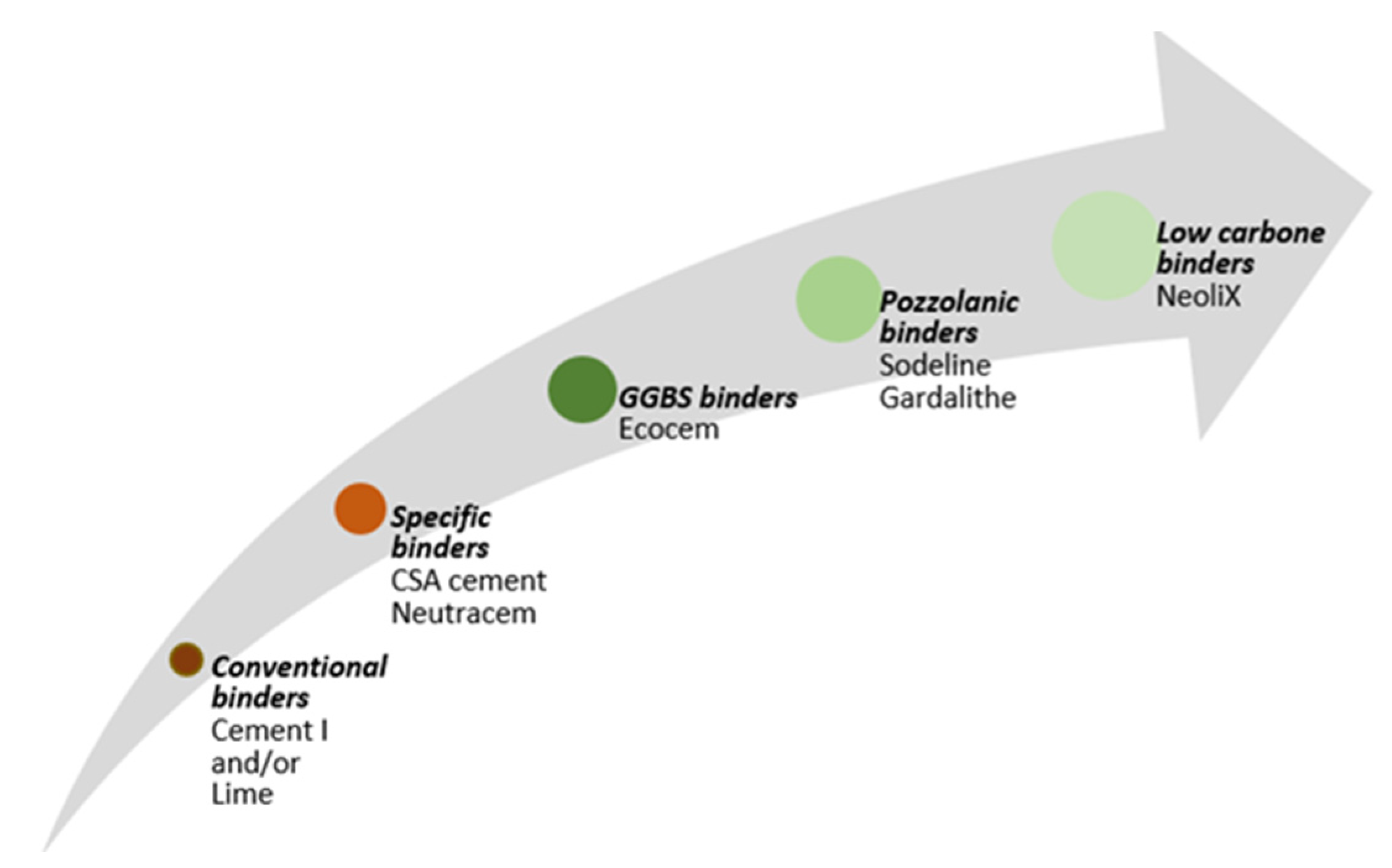

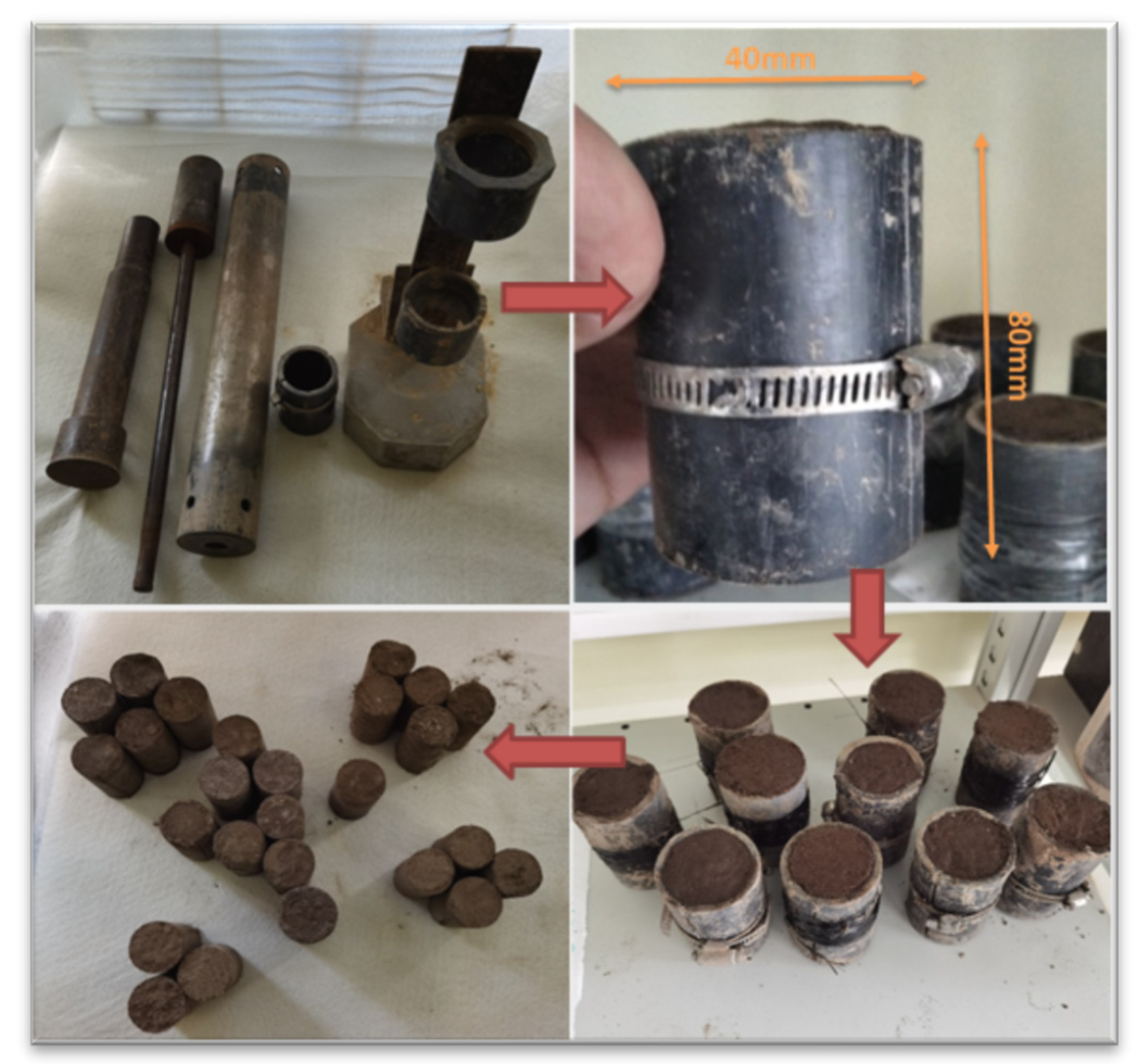
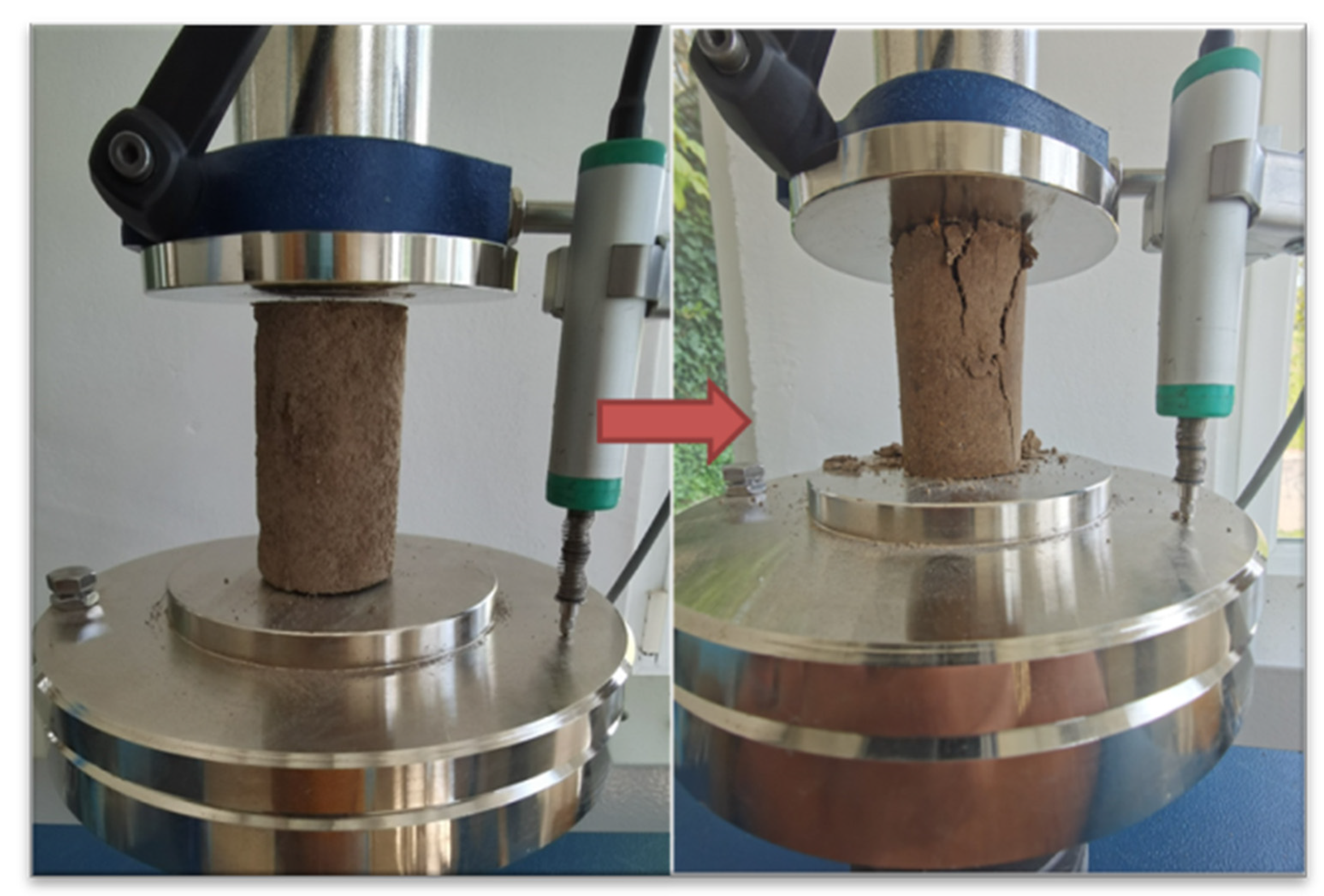



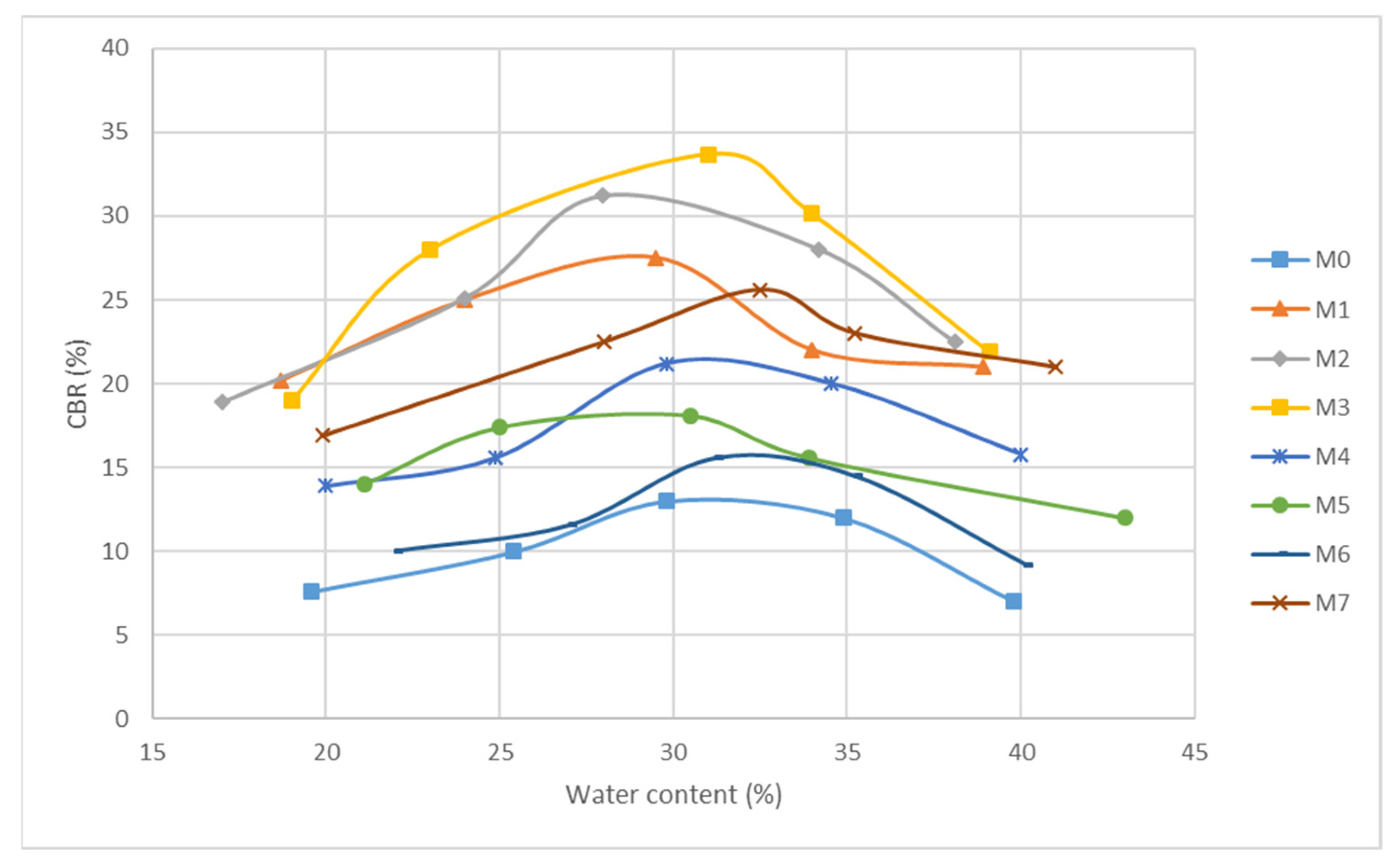
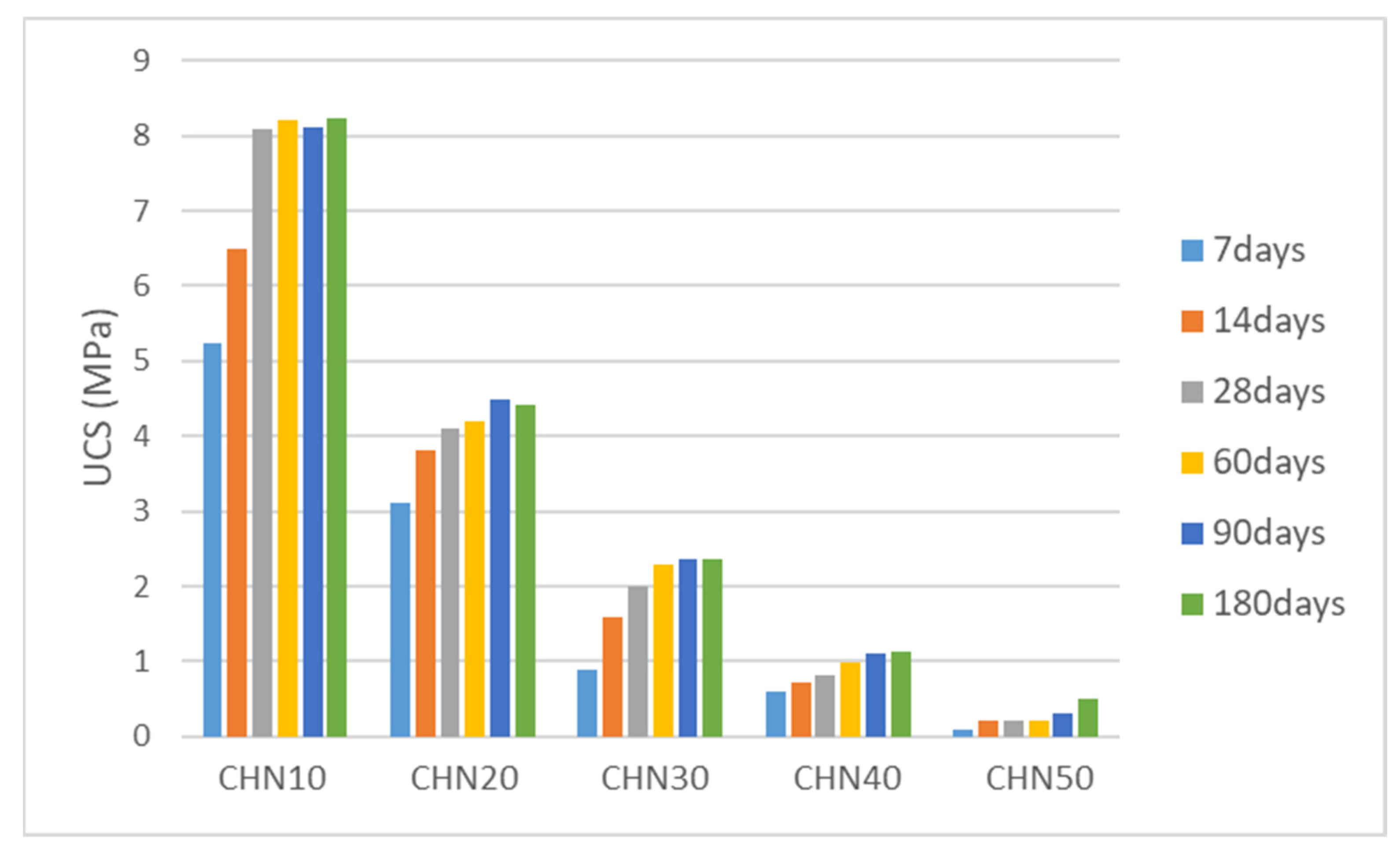
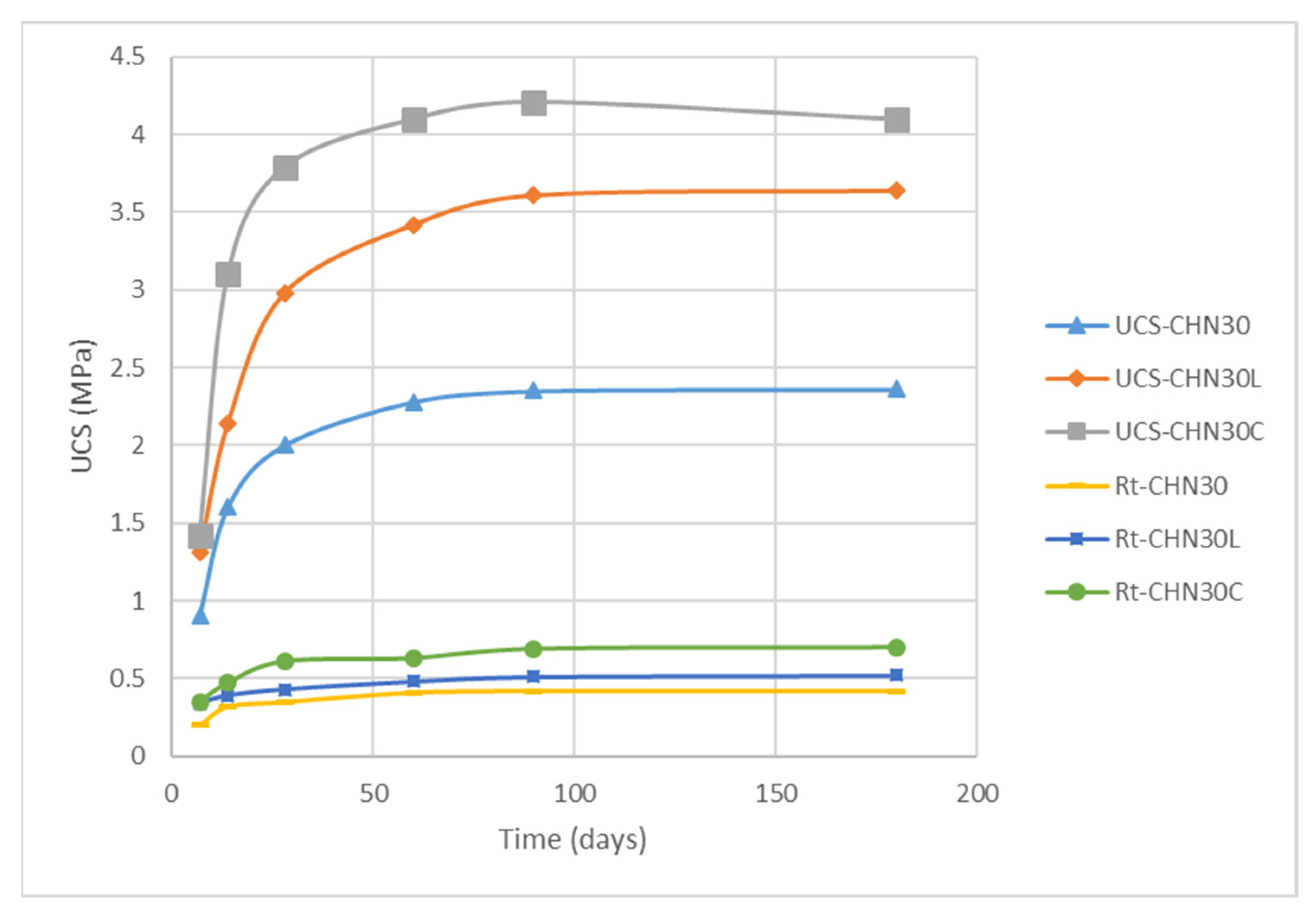
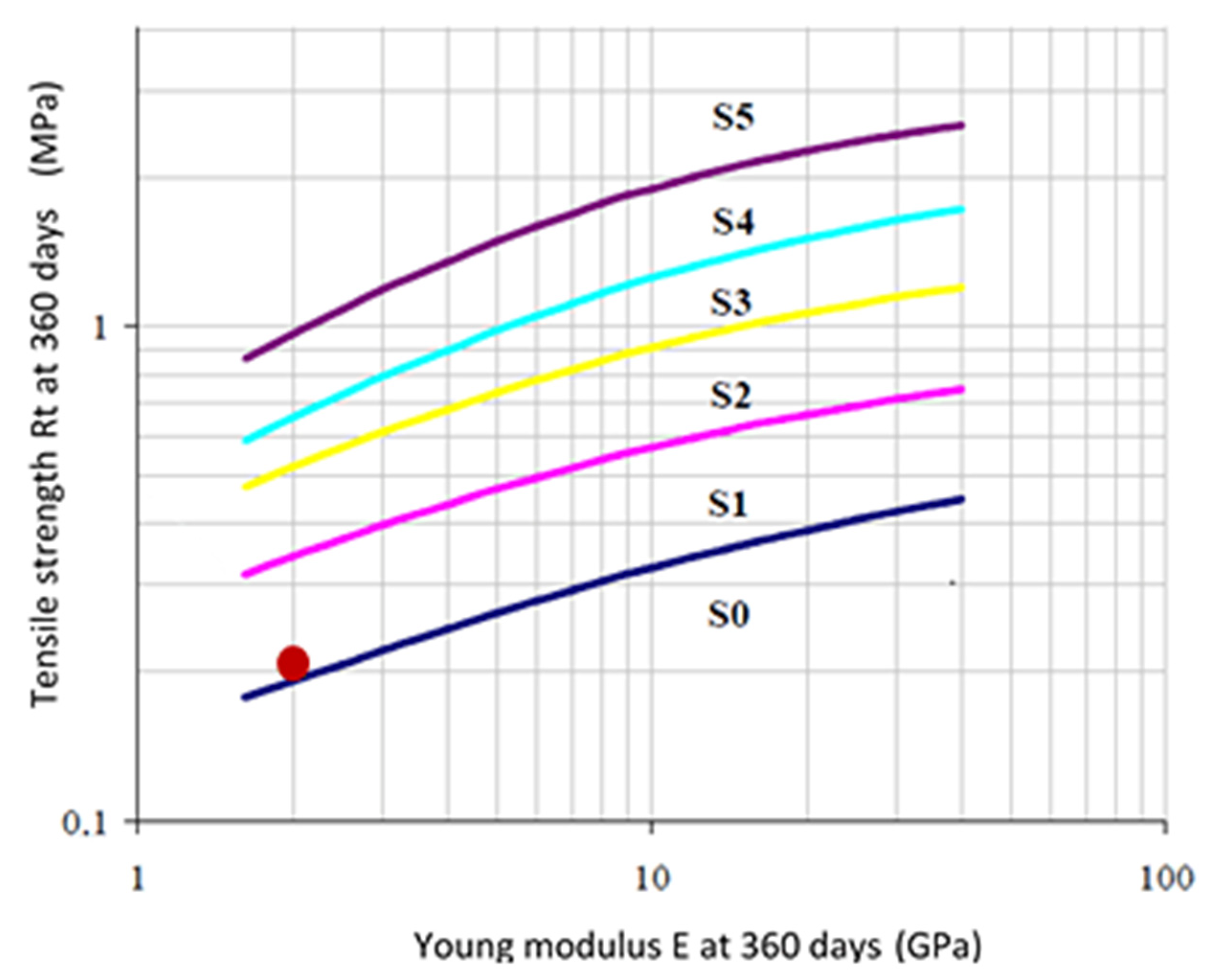
| Type of Test | Methods and Tests | Test Standards | Findings |
|---|---|---|---|
| Sieve analysis | Laser diffraction method | ISO 13320, 2020 | Cu, Cc, Dmax |
| Density | Helium gas pycnometer method | DIN 51913, 2013 | γs (g/cm3) |
| Clay contents | Methylene blue adsorption test | NF P94-068, 1998 | MBV (g/100 g) |
| Water content | By heating in oven at 60° | NF P94-050, 1990 | W (%) |
| Atterberg Limits | Liquidity at the cup/plasticity with a roll | NF P94-051, 1993 | LL, PL, PI, CI (%) |
| Organic matter | Method by calcination | NF XP P94-047, 1998 | OM (%) |
| Carbonates | Calcimeter method | NF P94-048, 1996 | CaCO3 (%) |
| Compaction | Miniature Proctor test | NF P94-093, 2014 | MDD, OMC |
| Characteristic | Symbols | CHER-1 | CHER-2 | CHER-3 | Used Standard |
|---|---|---|---|---|---|
| Maximum particle size | Avg. Dmax (mm) | 20 | 20 | 20 | ISO 13320-1, 2020 |
| Size under 80 μm | Avg. Size < 80 μm (%) | >70 | >70 | >70 | ISO 13320-1, 2020 |
| Size under 2 mm | Avg. Size < 2 mm (%) | >99 | >99 | >99 | ISO 13320-1, 2020 |
| Coeffient of curvature | Avg. Cc | 10.29 | 11.78 | 12.91 | ISO 13320-1, 2020 |
| Uniformity coeffient | Avg. Cu | 0.93 | 0.95 | 0.97 | ISO 13320-1, 2020 |
| Dry density | γs (g/cm3) | 2.27 | 2.34 | 2.25 | DIN 51913, 2013 |
| Methylene blue value | Avg. MBV (g/100 g) | 1.62 | 1.59 | 1.61 | NF P94-068, 1998 |
| Natural water content | Avg. wn (%) | >150 | >150 | >150 | NF P94-050, 1990 |
| Plasticity index | Avg. PI (%) | 20.84 | 22.97 | 23.53 | NF P94-051, 1993 |
| Organic matter content | Avg. OM (%) | 16.75 | 15.68 | 19.68 | NF XP P94-047, 1998 |
| Carbonates | Avg. Carbonates (%) | 8.25 | 3.66 | 2.35 | NF P94-048, 1996 |
| Maximum dry density | MDD (g/cm3) | 1.43 | 1.38 | 1.41 | NF P94-093, 2014 |
| Optimum moisture content | OMC (%) | 27.50 | 28.00 | 33.50 | NF P94-093, 2014 |
| Relation between wn and OMC | Relation wn and OMC | wn > 1.3OMC | wn > 1.3OMC | wn > 1.3OMC | GTR, 2000 |
| Soil class | Soil class | A2 | A2 | A2 | GTR, 2000 |
| Humidity nature | Humidity nature | Very humid | Very humid | Very humid | GTR, 2000 |
| Samples | Cd | Ni | Pb | Cu | Zn | Hg | As | V | Cr | Cu |
|---|---|---|---|---|---|---|---|---|---|---|
| CHER-1 | 0.16 | 13.53 | 70.89 | 22.40 | 223.74 | 0.32 | 7.79 | 54.43 | 62.7 | 22.40 |
| CHER-2 | 0.18 | 14.01 | 69.10 | 20.11 | 221.80 | 0.41 | 8.50 | 60.12 | 60.8 | 24.60 |
| CHER-3 | 0.20 | 13.43 | 70.15 | 23.96 | 225.12 | 0.25 | 12.10 | 41.00 | 58.9 | 20.50 |
| N1 | 1.20 | 37.00 | 100.00 | 45.00 | 276.00 | 0.40 | 25.00 | 75.00 | 90.00 | 45.00 |
| N2 | 2.40 | 74.00 | 200.00 | 90.00 | 552.00 | 0.80 | 50.00 | 120.00 | 180.00 | 90.00 |
| Nature | Clay (%) | Fine Silt (%) | Coarse silt (%) | Fine sand (%) | Medium sand (%) | Total silt (%) | Total sand (%) | |||
| CHER-1 | 6.60 | 47.40 | 26.00 | 19.10 | 0.90 | 73.40 | 20.00 | |||
| CHER-2 | 5.10 | 44.40 | 20.30 | 20.60 | 9.60 | 64.70 | 30.20 | |||
| CHER-3 | 4.81 | 38.69 | 23.71 | 25.50 | 7.29 | 62.40 | 32.79 | |||
| Characteristic | Numerical Value |
|---|---|
| Solubility in water (T = 20 °C) | <1.5 g/L |
| Relative density (specific gravity) | 2.85–2.95 |
| Bulk density | 0.95 |
| pH (T = 20 °C in water) | 9.8 |
| Boiling point | >1250 °C |
| Stability (expansion) | 1 mm (according to NF EN 196-3, 2017) |
| Set start time | 220 min (according to NF EN 196-3, 2017) |
| Activity index at 28 days | 98% (NF EN 196-1, 2016) |
| Specific surface area (SSA) | 4005.80 cm2/g |
| Characteristic | Numerical Value |
|---|---|
| Origin | bituminous coal |
| Activity index at 28 days | 70% to 80% (NF EN 196-1, 2016) |
| Density | 1.48 g/cm3 |
| pH | 10 |
| Specific surface area (SSA) | 1811.50 cm2/g |
| Material | SiO2 | Al2O3 | Fe2O3 | K2O | CaO | MgO | H2O |
|---|---|---|---|---|---|---|---|
| GGBS | 37.00 | 10.80 | - | - | 43.00 | 7.10 | - |
| FA | 46.81 | 20.45 | 7.09 | 4.35 | 12.52 | 3.12 | - |
| NeoliX® | 36.1 | - | - | - | - | - | 50% |
| Material | d10 (µm) | d50 (µm) | d90 (µm) | SSA (cm2/g) |
|---|---|---|---|---|
| Lime | 0.78 | 14.39 | 47.67 | 3213.70 |
| OPC | 2.55 | 17.18 | 41.22 | 2326.10 |
| GGBS | 0.54 | 11.58 | 35.39 | 4005.80 |
| FA | 1.95 | 24.66 | 229.00 | 1811.50 |
| CSA cement | 2.20 | 18.08 | 43.68 | 2396.90 |
| CHER-1 | 3.88 | 22.20 | 152.50 | 1152.85 |
| CHER-2 | 6.25 | 48.39 | 494.62 | 688.44 |
| CHER-3 | 6.03 | 47.03 | 565.40 | 705.30 |
| Sand | 0.45 | 7.45 | 22.68 | 4639.80 |
| Formation Name | Binder Used | Percentage by Weight (%) | OMC (%) |
|---|---|---|---|
| M0 | non | 0 | 29.30 |
| M1 | OPC | 9 | 30.5 |
| M2 | OPC + lime | 6 + 3 | 30.20 |
| M3 | OPC + lime | 4 + 5 | 30.30 |
| M4 | OPC + lime + QS | 6 + 3 + 25 | 30.10 |
| M5 | OPC + lime + QS | 6 + 3 + 15 | 30.40 |
| M6 | CSA cement | 9 | 30.05 |
| M7 | OPC + FA | 9 + 2 | 30.10 |
| Formation Name | Binder Used | Percentage by Weight (%) | w (%) |
|---|---|---|---|
| M8 | GGBS + activator | Different percentages | 50.00 |
| M9 | Fly-ash + activator | Different percentages | 50.00 |
| Testing Type | Total Samples |
|---|---|
| UCS to be tested at 7, 14, 28, 60, 90, and 180 days (3 samples per day) | 18 |
| Wet/dry method (w/d), freeze/thaw method (f/th) (3 samples per test) | 6 |
| Activator (%) | Water (%) | GGBS (%) | UCSGGBS (MPa) | FA (%) | UCSFA (MPa) |
|---|---|---|---|---|---|
| 1 | 50 | 99 | 0 | 99 | 0 |
| 2 | 50 | 98 | 0 | 98 | 0 |
| 3 | 50 | 97 | 0 | 97 | 0 |
| 4 | 50 | 96 | 0 | 96 | 0 |
| 5 | 50 | 95 | 0.19 | 95 | 0 |
| 6 | 50 | 94 | 0.2 | 94 | 0.12 |
| 7 | 50 | 93 | 0.35 | 93 | 0.12 |
| 8 | 50 | 92 | 1.3 | 92 | 0.13 |
| 9 | 50 | 91 | 7.1 | 91 | 0.136 |
| 10 | 50 | 90 | 10.85 | 90 | 0.25 |
| 15 | 50 | 85 | 14.1 | 85 | 0.32 |
| 20 | 50 | 80 | 14.9 | 80 | 0.56 |
| 30 | 50 | 70 | 14.94 | 70 | 0.32 |
| 40 | 50 | 60 | 8.5 | 60 | 0.30 |
| 50 | 50 | 50 | 7.03 | 50 | 0.25 |
| Water (%) | Activator (%) | GGBS (%) | Sediments (%) | Reference |
|---|---|---|---|---|
| 50 | 10 | 80 | 10 | CHN10 |
| 50 | 10 | 70 | 20 | CHN20 |
| 50 | 10 | 60 | 30 | CHN30 |
| 50 | 10 | 50 | 40 | CHN40 |
| 50 | 10 | 40 | 50 | CHN50 |
| Water (%) | NeoliX® (%) | GGBS (%) | Sediments (%) | Lime (%) | Granicalcium (%) | Reference |
|---|---|---|---|---|---|---|
| 50 | 10 | 60 | 30 | 0 | 0 | CHN30 |
| 50 | 10 | 55 | 30 | 5 | 0 | CHN30L |
| 50 | 10 | 57 | 30 | 0 | 3 | CHN30C |
Publisher’s Note: MDPI stays neutral with regard to jurisdictional claims in published maps and institutional affiliations. |
© 2022 by the authors. Licensee MDPI, Basel, Switzerland. This article is an open access article distributed under the terms and conditions of the Creative Commons Attribution (CC BY) license (https://creativecommons.org/licenses/by/4.0/).
Share and Cite
Hussan, A.; Levacher, D.; Mezazigh, S.; Jardin, L. Valorization of a Highly Organic Sediment: From Conventional Binders to a Geopolymer Approach. J. Compos. Sci. 2022, 6, 147. https://doi.org/10.3390/jcs6050147
Hussan A, Levacher D, Mezazigh S, Jardin L. Valorization of a Highly Organic Sediment: From Conventional Binders to a Geopolymer Approach. Journal of Composites Science. 2022; 6(5):147. https://doi.org/10.3390/jcs6050147
Chicago/Turabian StyleHussan, Ali, Daniel Levacher, Salim Mezazigh, and Louis Jardin. 2022. "Valorization of a Highly Organic Sediment: From Conventional Binders to a Geopolymer Approach" Journal of Composites Science 6, no. 5: 147. https://doi.org/10.3390/jcs6050147
APA StyleHussan, A., Levacher, D., Mezazigh, S., & Jardin, L. (2022). Valorization of a Highly Organic Sediment: From Conventional Binders to a Geopolymer Approach. Journal of Composites Science, 6(5), 147. https://doi.org/10.3390/jcs6050147








